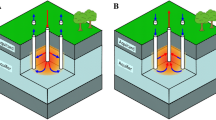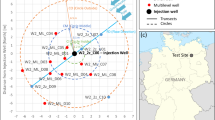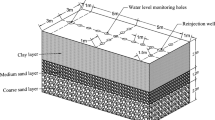Abstract
The efficiency of heat recovery in high-temperature (>60 °C) aquifer thermal energy storage (HT-ATES) systems is limited due to the buoyancy of the injected hot water. This study investigates the potential to improve the efficiency through compensation of the density difference by increased salinity of the injected hot water for a single injection-recovery well scheme. The proposed method was tested through numerical modeling with SEAWATv4, considering seasonal HT-ATES with four consecutive injection-storage-recovery cycles. Recovery efficiencies for the consecutive cycles were investigated for six cases with three simulated scenarios: (a) regular HT-ATES, (b) HT-ATES with density difference compensation using saline water, and (c) theoretical regular HT-ATES without free thermal convection. For the reference case, in which 80 °C water was injected into a high-permeability aquifer, regular HT-ATES had an efficiency of 0.40 after four consecutive recovery cycles. The density difference compensation method resulted in an efficiency of 0.69, approximating the theoretical case (0.76). Sensitivity analysis showed that the net efficiency increase by using the density difference compensation method instead of regular HT-ATES is greater for higher aquifer hydraulic conductivity, larger temperature difference between injection water and ambient groundwater, smaller injection volume, and larger aquifer thickness. This means that density difference compensation allows the application of HT-ATES in thicker, more permeable aquifers and with larger temperatures than would be considered for regular HT-ATES systems.
Résumé
Le rendement de la récupération de la chaleur dans des systèmes de stockage d’énergie thermique en aquifère à haute température (>60 °C) (HT-ATES) est limitée à cause de la force ascensionnelle de l’eau chaude injectée. Cette étude examine dans quelle mesure il est possible d’améliorer le rendement grâce à la compensation de la différence de densité en augmentant la salinité de l’eau chaude injectée pour un puits unique d’injection-récupération. La méthode proposée a été testée par le biais d’un modèle numérique utilisant le code SEAWATv4 considérant un HT-ATES saisonnier de quatre cycles consécutifs d’injection-stockage-récupération. Les rendements de récupération pour les cycles consécutifs ont été étudiés pour six cas avec trois scénarios simulés : (a) HT-ATES ordinaire, (b) HT-ATES avec une compensation de la différence de densité en utilisant une eau salée, et (c) HT-ATES théorique ordinaire sans convection thermique libre. Pour le cas de référence, dans lequel une eau de 80 °C a été injectée dans un aquifère à perméabilité élevée, le HT-ATES ordinaire avait un rendement de 0.40 après quatre cycles consécutifs de récupération. La méthode de compensation de la différence de densité conduit à un rendement de 0.69, se rapprochant du cas théorique (0.76). L’analyse de sensibilité a montré que l’augmentation du rendement net en utilisant la méthode de compensation de la différence de densité au lieu d’un HT-ATES ordinaire est plus grande pour une conductivité hydraulique d’aquifère plus élevée, une plus grande différence de température entre l’injection et l’eau souterraine environnante, un plus petit volume injecté, et une plus grande épaisseur d’aquifère. Cela signifie que la compensation de la différence de densité permet l’application d’un HT-ATES dans des aquifères plus épais, plus perméables et avec de plus grandes températures que ce qui pourrait être considéré pour des HT-ATES ordinaires.
Resumen
La eficiencia de recuperación de calor en sistemas de almacenamiento de energía térmica (HT-ATES) en acuíferos de alta temperatura (>60 °C) es limitada debido a la flotabilidad del agua caliente inyectada. Este estudio investiga el potencial de mejorar la eficiencia a través de la compensación de la diferencia de densidad por el aumento de la salinidad del agua caliente inyectada para un esquema de pozos de recuperación de inyección única. El método propuesto se puso a prueba a través de la modelización numérica con SEAWATv4 considerando un HT-ATES estacional de cuatro ciclos consecutivos de almacenamiento y recuperación de la inyección. Se investigaron las eficiencias de recuperación para ciclos consecutivos de seis casos con tres escenarios simulados: (a) HT-ATES regular, (b) HT-ATES con la compensación de la diferencia de densidad usando agua salina, y (c) HT-ATES teórico regular sin convección térmica libre. Para el caso de referencia, en el que se inyectó el agua a 80 °C en un acuífero de alta permeabilidad, el HT-ATES regular tenía una eficiencia de 0.40 después de cuatro ciclos de recuperación consecutivos. El método de compensación por diferencia de densidad dio lugar a una eficiencia de 0.69, que se aproxima al caso teórico (0.76). El análisis de sensibilidad mostró que el aumento neto de la eficiencia mediante el uso del método de compensación de diferencia de densidad en lugar del HT-ATES regular es mayor para una conductividad hidráulica del acuífero más alta, para una mayor diferencia de temperatura entre la inyección y el agua subterránea, para un volumen de inyección más pequeño, y para un mayor espesor del acuífero. Esto significa que la compensación por diferencia de densidad permite la aplicación de HT-ATES en acuíferos de mayor espesor y más permeables y con temperaturas mayores de lo que se considera para los sistemas regulares de HT-ATES.
摘要
由于注入的热水浮性,高温(>60 °C)含水层热能储存系统热回收效率受到限制。本项研究调查了通过密度差补偿提高效率的潜力,密度差补偿通过单个的注入-回收计划中注入的热水增加的盐度来完成。考虑到四个连续的注入-储存-回收周期的季节性高温含水层热能储存,通过采用SEAWATv4数值模拟对所提出的方法进行了检测。研究了连续周期回收效率三种模拟方案下的六种情况:(a)常规的高温含水层热能储存,(b)伴有采用咸水进行密度差补偿的高温含水层热能储存,(c)没有自由热对流的理论上常规的高温含水层热能储存。在80°C热水注入到高透水性含水层的参考案例中,常规的高温含水层热能储存的效率在四个连续的回收周期之后为0.40。密度差补偿方法的效率为0.69,接近理论案例(0.76)。灵敏度分析显示,采用密度差补偿方法而不是采用常规的高温含水层热能储存,纯效率在较高的含水层水力导水系数下增加的要多,注入水和周围地下水之间的温度差要大,注入量较小,含水层厚度较大。这意味着,密度差补偿可以在比适用于常规高温含水层热能储存系统的含水层有更高温度、厚度更大、透水性更大的含水层中应用高温含水层热能储存。
Samenvatting
Het terugwinrendement van warmte tijdens ondergrondse hoge temperatuur opslag (HTO, >60 °C) wordt beperkt door de thermisch-gedreven opdrijving van het geïnjecteerde hete water. In deze studie is onderzocht of voor een HTO-put het rendement waarmee geïnjecteerde warmte kan worden teruggewonnen verbeterd kan worden met het verhogen van de saliniteit van het geïnjecteerde hete water om zo het dichtheidsverschil te compenseren. Middels numerieke simulatie in SEAWATv4 is deze methode om dichtheidsverschil te compenseren getest voor seizoensgebonden HTO voor vier opeenvolgende cycli van injectie-opslag-recovery. Het terugwinrendement voor de opeenvolgende cycli is onderzocht voor zes gevallen met elk drie gemodelleerde scenario’s: (a) conventionele HTO, (b) HTO met dichtheidsverschil-compensatie door gebruik te maken van zout water, (c) conventionele HTO voor een theoretisch scenario zonder opdrijving. Het terugwinrendement tijdens conventionele HTO is 0.40 na vier cycli voor de conventionele HTO, waarbij water van 80 °C is geïnjecteerd in een grondwaterpakket met een hoge permeabiliteit. Met de dichtheidsverschil-compensatie methode is het terugwinrendement 0.69. Deze waarde ligt dicht in de buurt van het rendement voor het theoretische scenario (0.76). De gevoeligheidsanalyse laat zien dat de toename in terugwinrendement met de dichtheidsverschil-compensatie methode ten opzichte van conventionele HTO het grootst is voor de gevallen met een hogere doorlatendheid van het grondwaterpakket, grotere temperatuurverschillen tussen injectiewater en grondwater, kleinere injectievolumes en dikkere grondwaterpakketten. Dit betekent dat het gebruik van dichtheidsverschil-compensatie tijdens HTO het mogelijk maakt HTO toe te passen in grondwaterpakketten met een grotere dikte en een hogere doorlatendheid en met hogere injectie temperaturen, dan welke er tot nu toe gebruikelijk worden beschouwd voor conventionele HTO-systemen.
Resumo
A eficiência da recuperação de calor em altas temperaturas (>60 °C) em sistemas aquíferos de armazenamento de energia térmica (high-temperature aquifer thermal energy storage/HT-ATES) é limitada devido a força hidrostática da água quente injetada. Este estudo investiga o potencial para melhor a eficiência através da compensação da diferença de densidade por aumento de salinidade da água quente injetada por um sistema de poço de injeção-recuperação único. O método proposto foi testado através da modelagem numérica com SEAWATv4 considerando HT-ATES sazonais de quatro ciclos consecutivos de injeção-armazenamento-recuperação. Eficiências de recuperação para os ciclos consecutivos foram investigadas por seis casos com três cenários simulados: (a) HT-ATES regular, (b) HT-ATES com compensação da diferença de densidade usando água salina, e (c) HT-ATES regular teórico sem convecção térmica livre. Para o caso de referência, no qual a água à 80 °C foi injetada para dentro do aquífero de alta-permeabilidade, HT-ATES regular teve uma eficiência de 0.40 depois de quatro ciclos consecutivos de recuperação. O método de compensação da diferença de densidade resultou numa eficiência de 0.69, aproximando-se ao caso teórico (0.76). Análise de sensibilidade mostrou que o aumento na eficiência líquida por uso do método de compensação da diferença de densidade ao invés do HT-ATES regular é maior para maiores condutividades hidráulicas do aquífero, maior diferença de temperatura entre injeção e águas subterrâneas ambientes, menor volume de injeção, e maior espessura do aquífero. Isto significa que a compensação da diferença de densidade permite a aplicação de HT-ATES em aquíferos mais espessos, mais permeáveis e com temperatura maior do que poderia ser considerado por sistemas HT-ATES regulares.











Similar content being viewed by others
References
Bodvarsson GS (1982) Mathematical modeling of the behavior of geothermal systems under exploitation. PhD Thesis, University of California at Berkeley; and as Rep. LBL-13937, Lawrence Berkeley Lab, Berkeley, CA
Bonte M, van Breukelen BM, Stuyfzand PJ (2013) Temperature-induced impact on groundwater quality and arsenic mobility in anoxic aquifer sediments used for both drinking water and shallow geothermal energy production. Water Res 47(14):5088–5100. doi:10.1016/j.watres.2013.05.049
Brons HJ, Griffioen J, Appelo CAJ, Zehnder AJB (1991) (Bio)geochemical reactions in aquifer material from a thermal energy storage site. Water Res 25(6):729–736. doi:10.1016/0043-1354(91)90048-U
Brown DL, Silvey WD (1977) Artificial recharge to a freshwater-sensitive brackish-water sand aquifer. US Geol Surv Prof Pap 939
Buscheck TA, Doughty C, Tsang CF (1983) Prediction and analysis of a field experiment on a multilayered aquifer thermal energy storage system with strong buoyancy flow. Water Resour Res 19(5):1307–1315. doi:10.1029/WR019i005p01307
Doughty C, Hellström G, Tsang CF, Claesson J (1982) A dimensionless parameter approach to the thermal behavior of an aquifer thermal energy storage system. Water Resour Res 18(3):571–587. doi:10.1029/WR018i003p00571
Griffioen J, Appelo CAJ (1993) Nature and extent of carbonate precipitation during aquifer thermal energy storage. Appl Geochem 8(2):161–176. doi:10.1016/0883-2927(93)90032-C
Guo W, Langevin CD (2002) User’s guide to SEAWAT: a computer program for simulation of three-dimensional variable-density ground-water flow. US Geol Surv Tech Water-Resour Invest 6-A7
Harbaugh AW, Banta ER, Hill MC, McDonald MG (2000) MODFLOW-2000, the US Geological Survey modular ground-water models: user guide to modularization concepts and the ground-water flow process. US Geol Surv Open-File Rep 00-92
Hartog N, Drijver B, Dinkla I, Bonte M (2013) Field assessment on the impact of Aquifer Thermal Energy Storage (ATES) systems on chemical and microbial groundwater compositions. European Geothermal Conference, Pisa, Italy, 3–7 June 2013
Hellström G, Tsang CF, Claesson J (1979) Heat storage in aquifers: buoyancy flow and thermal stratification problems. Institute of Technology, Lund, Sweden; and as Rep. LBL-14246, Lawrence Berkeley Lab, Berkeley, CA
Isdale JD, Morris R (1972) Physical properties of sea water solutions: density. Desalination 10(4):329–339. doi:10.1016/S0011-9164(00)80003-X
Kabus F, Seibt P (2000) Aquifer Thermal Energy Storage for the Berlin Reichstag building: new seat of the German Parliament. Proceedings of the World Geothermal Congress 2000, Kyushu, Tohoku, Japan, May 28–June 10 2000
Langevin CD (2008) Modeling axisymmetric flow and transport. Ground Water 46(4):579–590. doi:10.1111/j.1745-6584.2008.00445.x
Langevin CD, Thorne DT Jr., Dausman AM, Sukop MC, Guo W (2008) SEAWAT Version 4: a computer program for simulation of multi-species solute and heat transport. US Geological Surv Tech Meth 6-A22
Mathey B (1977) Development and resorption of a thermal disturbance in a phreatic aquifer with natural convection. J Hydrol 34(3–4):315–333. doi:10.1016/0022-1694(77)90139-1
Meyer CF, Todd DK (1973) Conserving energy with heat storage wells. Environ Sci Technol 7(6):512–516. doi:10.1021/es60078a009
Millero FJ, Poisson A (1981) International one-atmosphere equation of state of seawater. Deep-Sea Res 28A(6):625–629. doi:10.1016/0198-0149(81)90122-9
Miotliński K, Dillon PJ (2015) Relative recovery of thermal energy and fresh water in aquifer storage and recovery systems. Ground Water 53(6):877–884. doi:10.1111/gwat.12286
Miotliński K, Dillon PJ, Pavelic P, Barry K, Kremer S (2014) Recovery of injected freshwater from a brackish aquifer with a multiwell system. Ground Water 52(4):495–502. doi:10.1111/gwat.12089
Molz FJ, Melville JG, Parr AD, King DA, Hopf MT (1983a) Aquifer thermal energy storage: a well doublet experiment at increased temperatures. Water Resour Res 19(1):149–160. doi:10.1029/WR019i001p00149
Molz FJ, Melville JG, Güven O, Parr AD (1983b) Aquifer thermal energy storage: an attempt to counter free thermal convection. Water Resour Res 19(4):922–930. doi:10.1029/WR019i004p00922
Molz FJ, Parr AD, Andersen PF, Lucido VD, Warman JC (1979) Thermal energy storage in a confined aquifer: experimental results. Water Resour Res 15(6):1509–1514. doi:10.1029/WR015i006p01509
Oldenburg CM, Preuss K (1999) Plume separation by transient thermohaline convection in porous media. Geophys Res Lett 26(19):2997–3000. doi:10.1029/1999GL002360
Olsthoorn TN (1982) The clogging of recharge wells, main subjects. KIWA Communications-72, The Netherlands Testing and Research Institute, Rijswijk, The Netherlands
Palmer CD, Blowes DW, Frind EO, Molson JW (1992) Thermal energy storage in an unconfined aquifer, 1: field injection experiment. Water Resour Res 28(10):2845–2856. doi:10.1029/92WR01471
Pérez-Gonzaléz A, Urtiaga AM, Ibáñez R, Ortiz I (2012) State of the art and review on the treatment technologies of water reverse osmosis concentrates. Water Res 46(2):267–283. doi:10.1016/j.watres.2011.10.046
Réveillère A, Hamm V, Lesueur H, Cordier E, Goblet P (2013) Geothermal contribution to the energy mix of a heating network when using Aquifer Thermal Energy Storage: modeling and application to the Paris basin. Geothermics 47:69–79. doi:10.1016/j.geothermics.2013.02.005
Sanner B, Karytsas C, Mendrinos D, Ryback L (2003) Current status of ground source heat pumps and underground thermal energy storage in Europe. Geothermics 32(4–6):579–588. doi:10.1016/S0375-6505(03)00060-9
Sanner B, Kabus F, Seibt P, Bartels J (2005) Underground thermal energy storage for the German Parliament in Berlin: system concept and operational experiences. Proceedings of the World Geothermal Congress, Antalya, Turkey, 24–29 April 2005
Sauty JP, Gringarten AC, Menjoz A, Landel PA (1982) Sensible energy storage in aquifers, 1: theoretical study. Water Resour Res 18(2):245–252. doi:10.1029/WR018i002p00245
Schout G, Drijver B, Gutierrez-Neri M, Schotting R (2014) Analysis of recovery efficiency in high-temperature aquifer thermal energy storage: a Rayleigh-based method. Hydrogeol J 22(1):281–291. doi:10.1007/s10040-013-1050-8
Seibert S, Prommer H, Siade A, Harris B, Trefry M, Martin M (2014) Heat and mass transport during a groundwater replenishment trial in a highly heterogeneous aquifer. Water Resour Res 50(12):9463–9483. doi:10.1002/2013WR015219
Sharqawy MH, Lienhard VJH, Zubair SM (2010) Thermophysical properties of seawater: a review of existing correlations and data. Desalination Water Treat 16(1–3):354–380. doi:10.5004/dwt.2010.1079
Vandenbohede A, Louwyck A, Vlamynck N (2014) SEAWAT-based simulation of axisymmetric heat transport. Ground Water 52(6):908–915. doi:10.1111/gwat.12137
Van Lopik JH, Hartog N, Zaadnoordijk WJ, Cirkel DG, Raoof A (2015) Salinization in a stratified aquifer induced by heat transfer from well casings. Adv Water Resour 86A:32–45. doi:10.1016/j.advwatres.2015.09.025
Voss CI (1984) A finite-element simulation model for saturated-unsaturated, fluid-density-dependent ground-water flow with energy transport or chemically-reactive single-species solute transport. US Geol Surv Water Resour Invest Rep 84-4369
Wallis I, Prommer H, Post V, Vandenbohede A, Simmons CT (2013) Simulating MODFLOW-based reactive transport under radially symmetric flow conditions. Ground Water 51(3):398–413. doi:10.1111/j.1745-6584.2012.00978.x
Ward JD, Simmons CT, Dillon PJ (2007) A theoretical analysis of mixed convection in aquifer storage and recovery: how important are density effects? J Hydrol 343(3–4):169–186. doi:10.1016/j.jhydrol.2007.06.011
Zeghici RM, Oude Essink GHP, Hartog N, Sommer W (2015) Integrated assessment of variable density-viscosity flow for a high temperature aquifer thermal energy storage (HT-ATES) system in a deep geothermal reservoir. Geothermics 55:58–68. doi:10.1016/j.geothermics.2014.12.006
Zheng C, Wang PP (1999) MT3DMS: a modular three-dimensional multispecies transport model for simulation of advection, dispersion and chemical reactions of contaminant in ground-water systems: documentation and user’s guide. US Army Corps of Engineer Research and Development Center, Contract Report SERDP-99-1, University of Alabama, Vicksburg, MI
Zuurbier KG, Zaadnoordijk WJ, Stuyfzand PJ (2014) How multiple partially penetrating wells improve freshwater recovery of coastal aquifer storage and recovery (ASR) systems: a field and modeling study. J Hydrol 509:430–441. doi:10.1016/j.jhydrol.2013.11.057
Acknowledgements
The authors thank two anonymous reviewers for their constructive feedback, which allowed us to improve the manuscript significantly.
Author information
Authors and Affiliations
Corresponding author
Rights and permissions
About this article
Cite this article
van Lopik, J.H., Hartog, N. & Zaadnoordijk, W.J. The use of salinity contrast for density difference compensation to improve the thermal recovery efficiency in high-temperature aquifer thermal energy storage systems. Hydrogeol J 24, 1255–1271 (2016). https://doi.org/10.1007/s10040-016-1366-2
Received:
Accepted:
Published:
Issue Date:
DOI: https://doi.org/10.1007/s10040-016-1366-2




